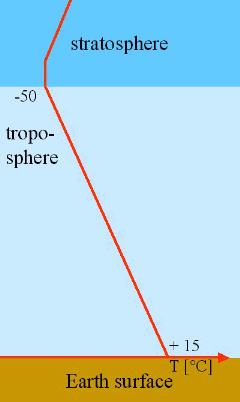Temperature profile and transport of air
Temperature falls with increasing altitude. It becomes colder in the troposphere, the higher we go. You feel it if you hike in the mountains. But there is a point in the atmosphere where this trend changes. This is the tropopause - a temperature minimum in the atmosphere. Some scientists call it a cold trap, because this is a point where ascending air cannot go higher. Imagine a parcel of air as shown on the right. You see, that it is stopped on the way upwards. This is important for the dynamics and the chemistry in the troposphere, for the cloud formation and the weather.
What is the reason? Warm air is lighter than cold air. We know this phenomenon from our daily life. If you open the door in winter, you always feel the cold air first at the feet, since it is heavier and sinks to the floor. Similarly, when the Earth warms up at the ground in the warm sunlight of the morning, the air at the ground becomes warmer and therefore lighter than the air farer away from the ground. The air at the ground starts ascending like a light baloon. As long as the air around is colder (= heavier) it can go on raising. At the tropopause this travel stops, because the air above is warmer and lighter. This is why it is rather difficult for water (clouds) and for the chemical compounds to cross this invisible temperature barrier at the tropopause. Therefore, most of the air chemistry and the weather take place in the troposphere. If water cannnot go higher than the troposphere, clouds cannot form anymore in higher layers, because clouds consist of water droplets.
The animation shows average temperatures at the ground (15°C) and at the tropopause (-50°C) and a rather simple temperature profile.
|
 |
 |
 |
|
2. Rising air
A parcel of warm air in the troposphere (red) rises and expands during its way up. It becomes cooler, as symbolised by the disappearing red color, but is always warmer than the surrounding air. Arriving at the tropopause it cannot rise further but can only expand in wideness.
author: Elmar Uherek
Please click to enlarge! (60 KB)
|
|









